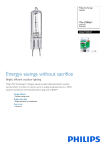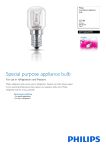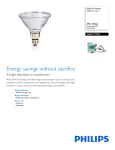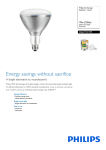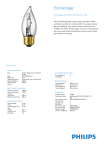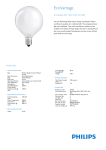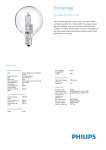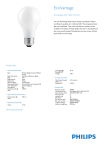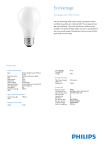Download Philips 046677428143 energy-saving lamp
Transcript
Philips EcoVantage Linear 150w (200w)* RSC base Bright light 046677428143 Energys savings without sacrifice Bright, efficient task lighting Philips 150W EcoVantage T3 halogen bulb provides bright light for work and security fixtures. It contains no mercury and is an energy saving alternative to a 200W standard incandescent with an estimated yearly energy cost of $18.07**. Energy efficient • Reduces energy costs Bright white light • Bright alternative to incandescent Easy to use • Instant on 046677428143 Linear 150w (200w)* RSC base, Bright light Specifications Bulb characteristics • • • • • Highlights • Color temperature: 2850 K • Light output: 570 lumen • Light effect/finish: Clear Shape: Linear Type: T3 Base: RSC Voltage: 120 V Dimmable Instant on Durability • Average life (at 2.7 hrs/day): 1.5 year(s) • Lifetime of lamps: 1650 hour(s) Power consumption • Wattage: 150 W • Wattage equivalent: 200 W Light characteristics Bulb dimensions • Height: 4.65 inch • Width: 0.47 inch • • Color rendering index (CRI): 100 Just by flipping the switch, your room is at full brightness. No slow starting or waiting. Substitute for incandescent This 40W Ecovantage flood light bulb provides a bright, white beam of light that is ideal for general room lighting. It is perfect for indoor recessed ceiling fixtures. Reduces energy costs This EcoVantage bulb saves up to 25% in electricity costs when compared to a 150W T3, and has an estimated yearly energy cost of $18.07**. Issue date 2014-09-12 © 2014 Koninklijke Philips N.V. All Rights reserved. Version: 3.2.1 Specifications are subject to change without notice. Trademarks are the property of Koninklijke Philips N.V. or their respective owners. 12 NC: 8670 001 09401 www.philips.com * *Based on 3 hrs/day, 11¢/kWh. Cost depends on rates and use. * Compared to a 200 watt standard halogen T3 rated at 3000 lumens, this 150 watt EcoVantage T3 provides 2850 lumens and saves 25% energy. * **1.5 years means rated average life based on engineering testing and probability analysis where the lamp is used on average 3 hours/day, 7 days a week.


